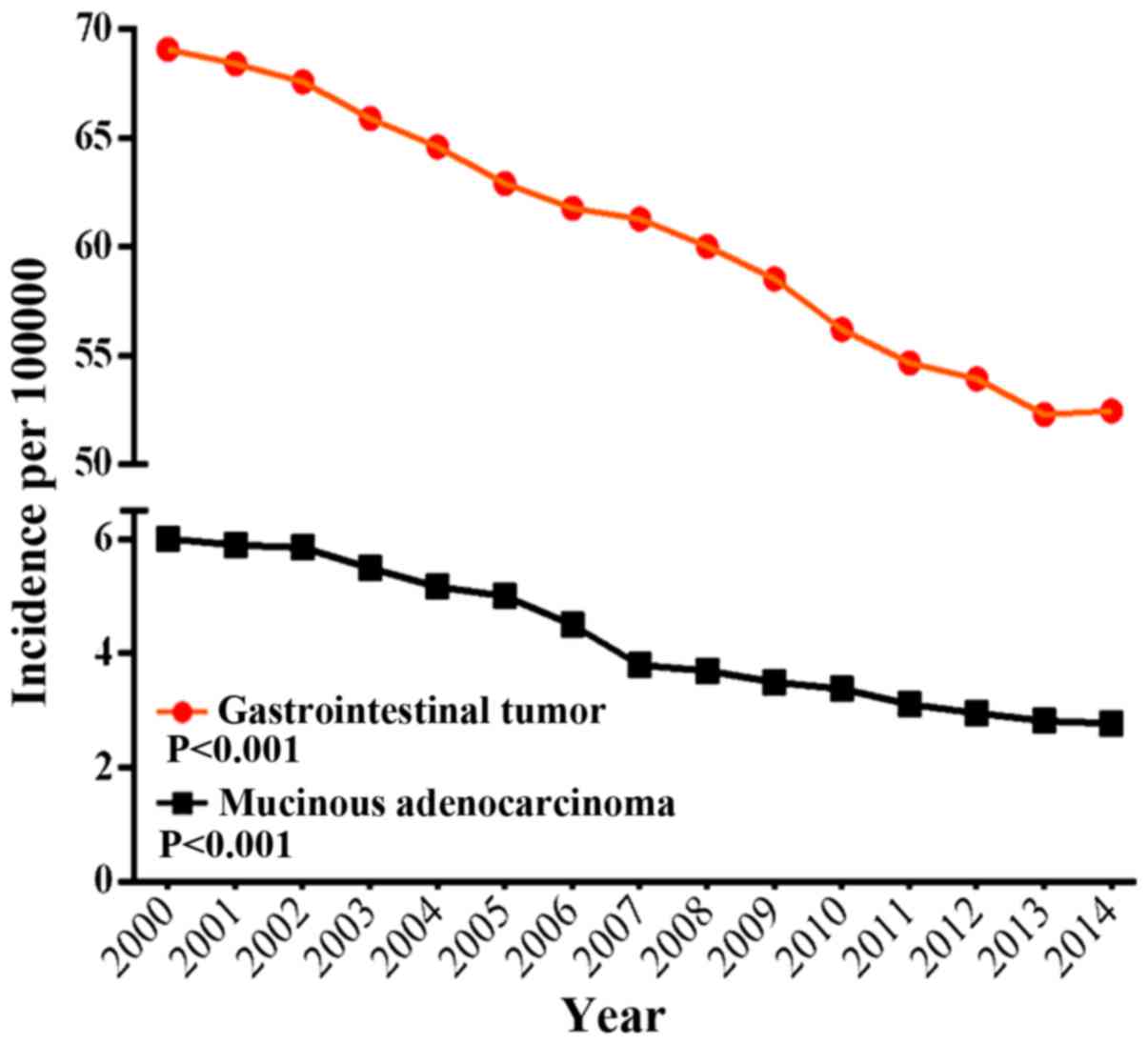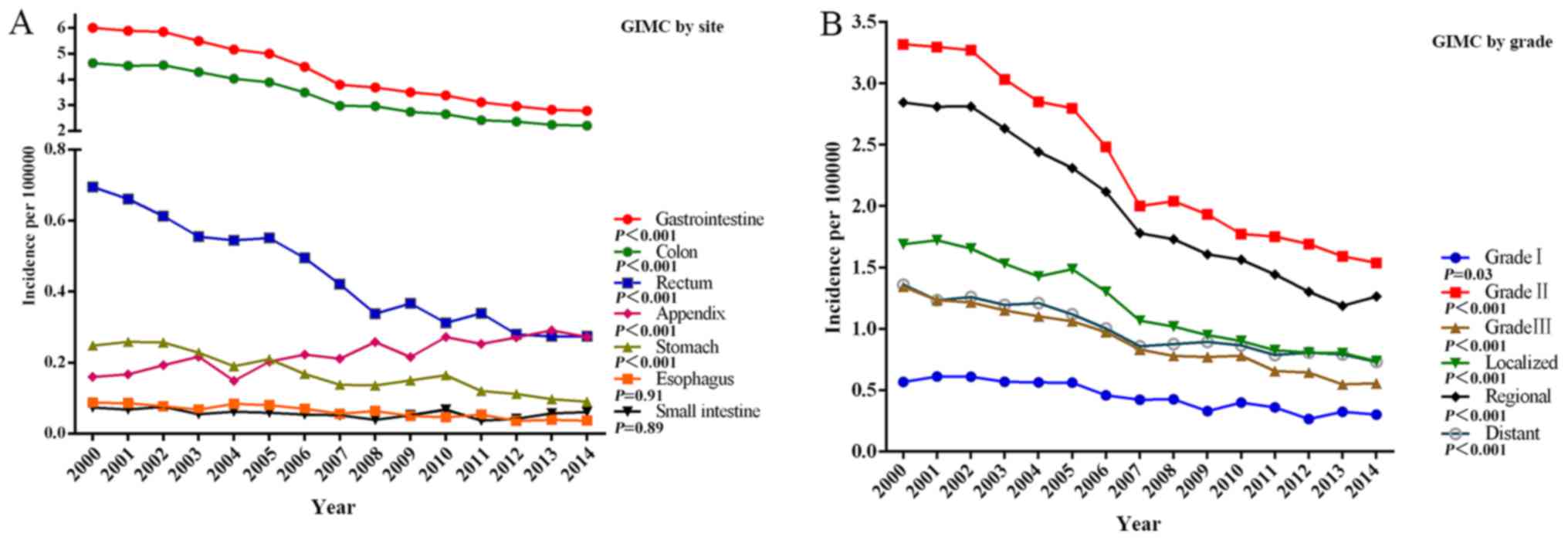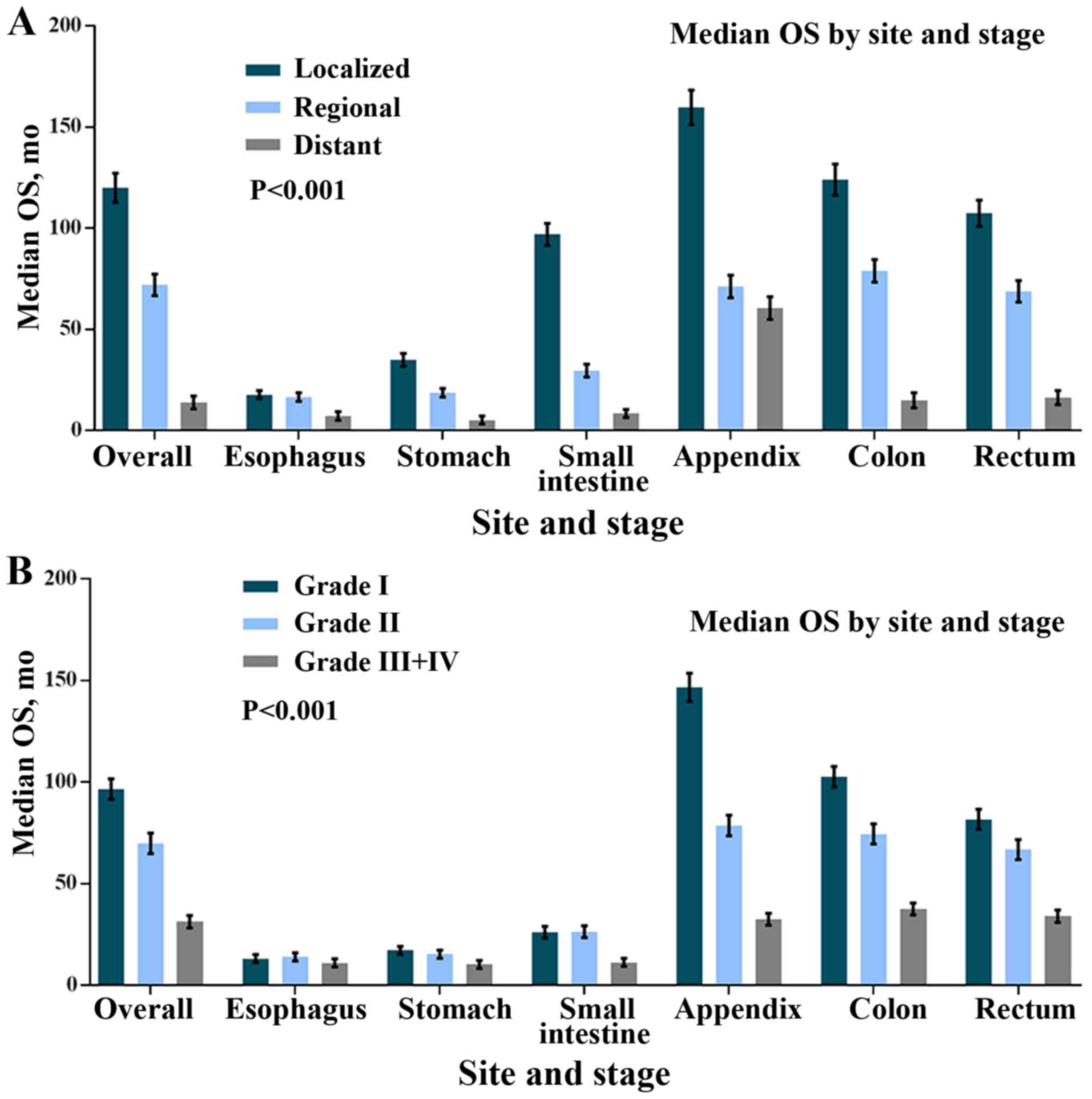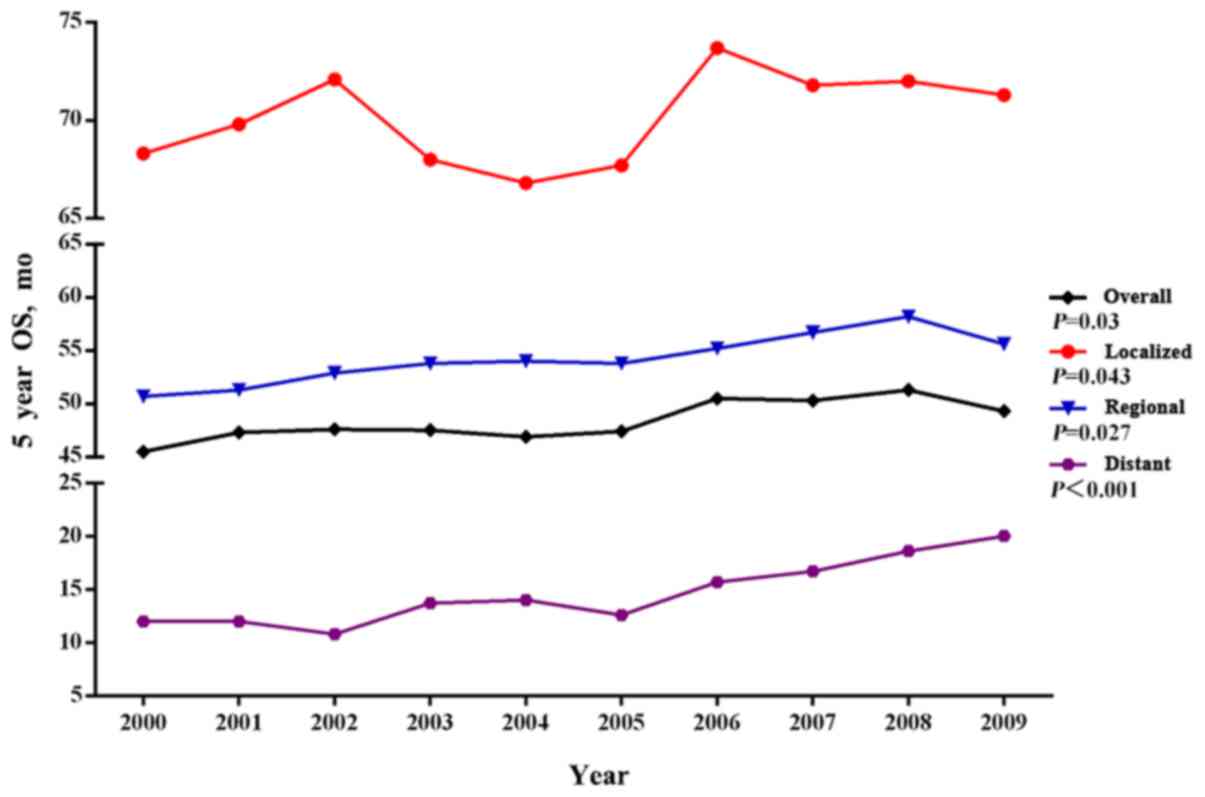|
1
|
Siegel RL, Miller KD and Jemal A: Cancer
Statistics, 2017. CA Cancer J Clin. 67:7–30. 2017. View Article : Google Scholar : PubMed/NCBI
|
|
2
|
Nitsche U, Zimmermann A, Späth C, Muller
T, Maak M, Schuster T, Slotta-Huspenina J, Kaser SA, Michalski CW,
Janssen KP, et al: Mucinous and signet-ring cell colorectal cancers
differ from classical adenocarcinomas in tumor biology and
prognosis. Ann Surg. 258:775–783. 2013. View Article : Google Scholar : PubMed/NCBI
|
|
3
|
Jass JR, Sobin LH and Watanabe H: The
World Health Organization's histologic classification of
gastrointestinal tumors. A commentary on the second edition.
Cancer. 66:2162–2167. 1990. View Article : Google Scholar : PubMed/NCBI
|
|
4
|
Pihl E, Nairn RC, Hughes ES, Cuthbertson
AM and Rollo AJ: Mucinous colorectal carcinoma: Immunopathology and
prognosis. Pathology. 12:439–447. 1980. View Article : Google Scholar : PubMed/NCBI
|
|
5
|
Hugen N, Brown G, Glynne-Jones R, de Wilt
JH and Nagtegaal ID: Advances in the care of patients with mucinous
colorectal cancer. Nat Rev Clin Oncol. 13:361–369. 2016. View Article : Google Scholar : PubMed/NCBI
|
|
6
|
Yin C, Li D, Sun Z, Zhang T, Xu Y, Wang Z
and Xu H: Clinicopathologic features and prognosis analysis of
mucinous gastric carcinoma. Med Oncol. 29:864–870. 2012. View Article : Google Scholar : PubMed/NCBI
|
|
7
|
van den Heuvel MG, Lemmens VE, Verhoeven
RH and de Hingh IH: The incidence of mucinous appendiceal
malignancies: A population-based study. Int J Colorectal Dis.
28:1307–1310. 2013. View Article : Google Scholar : PubMed/NCBI
|
|
8
|
Hyngstrom JR, Hu CY, Xing Y, You YN, Feig
BW, Skibber JM, Rodriguez-Bigas MA, Cormier JN and Chang GJ:
Clinicopathology and outcomes for mucinous and signet ring
colorectal adenocarcinoma: Analysis from the national cancer data
base. Ann Surg Oncol. 19:2814–2821. 2012. View Article : Google Scholar : PubMed/NCBI
|
|
9
|
Du W, Mah JT, Lee J, Sankila R,
Sankaranarayanan R and Chia KS: Incidence and survival of mucinous
adenocarcinoma of the colorectum: A population-based study from an
Asian country. Dis Colon Rectum. 47:78–85. 2004. View Article : Google Scholar : PubMed/NCBI
|
|
10
|
Xie L, Villeneuve PJ and Shaw A: Survival
of patients diagnosed with either colorectal mucinous or
non-mucinous adenocarcinoma: A population-based study in Canada.
Int J Oncol. 34:1109–1115. 2009. View Article : Google Scholar : PubMed/NCBI
|
|
11
|
Geronimus AT, Bound J and Ro A:
Residential mobility across local areas in the United States and
the geographic distribution of the healthy population. Demography.
51:777–809. 2014. View Article : Google Scholar : PubMed/NCBI
|
|
12
|
Aleman JO, Eusebi LH, Ricciardiello L,
Patidar K, Sanyal AJ and Holt PR: Mechanisms of obesity-induced
gastrointestinal neoplasia. Gastroenterology. 146:357–373. 2014.
View Article : Google Scholar : PubMed/NCBI
|
|
13
|
Shivanna Mysuru L and Urooj A: A review on
dietary and non-dietary risk factors associated with
gastrointestinal cancer. J Gastrointest Cancer. 47:247–254. 2016.
View Article : Google Scholar : PubMed/NCBI
|
|
14
|
Veitch AM, Uedo N, Yao K and East JE:
Optimizing early upper gastrointestinal cancer detection at
endoscopy. Nat Rev Gastroenterol Hepatol. 12:660–667. 2015.
View Article : Google Scholar : PubMed/NCBI
|
|
15
|
Songur Y, Okai T, Watanabe H, Fujii T,
Motoo Y and Sawabu N: Preoperative diagnosis of mucinous gastric
adenocarcinoma by endoscopic ultrasonography. Am J Gastroenterol.
91:1586–1590. 1996.PubMed/NCBI
|
|
16
|
Numata M, Shiozawa M, Watanabe T, Tamagawa
H, Yamamoto N, Morinaga S, Watanabe K, Godai T, Oshima T, Fujii S,
et al: The clinicopathological features of colorectal mucinous
adenocarcinoma and a therapeutic strategy for the disease. World J
Surg Oncol. 10:1092012. View Article : Google Scholar : PubMed/NCBI
|
|
17
|
Tang X, Zhang J, Che X, Lan Z, Chen Y and
Wang C: The clinicopathological features and long-term survival
outcomes of mucinous gastric carcinoma: A consecutive series of 244
cases from a single institute. J Gastrointest Surg. 20:693–699.
2016. View Article : Google Scholar : PubMed/NCBI
|
|
18
|
Nitsche U, Rosenberg R, Balmert A,
Schuster T, Slotta-Huspenina J, Herrmann P, Bader FG, Friess H,
Schlag PM, Stein U and Janssen KP: Integrative marker analysis
allows risk assessment for metastasis in stage II colon cancer. Ann
Surg. 256:763–771. 2012. View Article : Google Scholar : PubMed/NCBI
|
|
19
|
Widmann B, Warschkow R, Schmied BM, Marti
L and Steffen T: Impact of mucinous histology on the prognosis of
stage I–III Adenocarcinomas of the appendix: A population-based,
propensity score-matched analysis. J Gastrointest Surg.
20:1493–1502. 2016. View Article : Google Scholar : PubMed/NCBI
|
|
20
|
Hsu JT, Chen HM, Liao CH, Yeh CN, Yeh TS,
Hwang TL, Jan YY and Chen MF: Clinicopathologic features and
predictors for survival of mucinous and non-mucinous appendiceal
adenocarcinoma. Dig Surg. 25:369–375. 2008. View Article : Google Scholar : PubMed/NCBI
|
|
21
|
Ramaswamy V: Pathology of mucinous
appendiceal tumors and pseudomyxoma peritonei. Indian J Surg Oncol.
7:258–267. 2016. View Article : Google Scholar : PubMed/NCBI
|
|
22
|
Carr NJ, Bibeau F, Bradley RF, Dartigues
P, Feakins RM, Geisinger KR, Gui X, Isaac S, Milione M, Misdraji J,
et al: The histopathological classification, diagnosis and
differential diagnosis of mucinous appendiceal neoplasms,
appendiceal adenocarcinomas and pseudomyxoma peritonei.
Histopathology. 71:847–858. 2017. View Article : Google Scholar : PubMed/NCBI
|
|
23
|
Misdraji J: Mucinous epithelial neoplasms
of the appendix and pseudomyxoma peritonei. Mod Pathol. 28 Suppl
1:S67–S79. 2015. View Article : Google Scholar : PubMed/NCBI
|
|
24
|
Sugarbaker PH: The natural history, gross
pathology, and histopathology of appendiceal epithelial neoplasms.
Eur J Surg Oncol. 32:644–647. 2006. View Article : Google Scholar : PubMed/NCBI
|
|
25
|
Ooki A, Akagi K, Yatsuoka T, Asayama M,
Hara H, Yamamoto G, Nishimura Y and Yamaguchi K: Inverse effect of
mucinous component on survival in stage III colorectal cancer. J
Surg Oncol. 110:851–857. 2014. View Article : Google Scholar : PubMed/NCBI
|
|
26
|
Hsu JT, Wang CW, Le PH, Wu RC, Chen TH,
Chiang KC, Lin CJ and Yeh TS: Clinicopathological characteristics
and outcomes in stage I–III mucinous gastric adenocarcinoma: A
retrospective study at a single medical center. World J Surg Oncol.
14:1232016. View Article : Google Scholar : PubMed/NCBI
|
|
27
|
Jimi S, Hotokezaka M, Ikeda T, Uchiyama S,
Hidaka H, Maehara N, Ishizaki H and Chijiiwa K: Clinicopathological
features, postoperative survival and prognostic variables for
cancer-related survival in patients with mucinous colorectal
carcinoma. Surg Today. 45:329–334. 2015. View Article : Google Scholar : PubMed/NCBI
|
|
28
|
Kawamura H, Kondo Y, Osawa S, Nisida Y,
Okada K, Isizu H, Uebayasi T, Takahasi M and Hata T: A
clinicopathologic study of mucinous adenocarcinoma of the stomach.
Gastric Cancer. 4:83–86. 2001. View Article : Google Scholar : PubMed/NCBI
|
|
29
|
Fiorica F, Stefanelli A, Pascale G and
Fisichella R: Elderly gastrointestinal cancer patients and
radiochemotherapy: A review. Clin Ter. 165:57–61. 2014.PubMed/NCBI
|
|
30
|
Sandler S: Esophagogastric junction and
gastric adenocarcinoma: Neoadjuvant and adjuvant therapy, and
future directions. Oncology (Williston Park). 28:505–512.
2014.PubMed/NCBI
|
|
31
|
Hogan J, Burke JP, Samaha G, Condon E,
Waldron D, Faul P and Coffey JC: Overall survival is improved in
mucinous adenocarcinoma of the colon. Int J Colorectal Dis.
29:563–569. 2014. View Article : Google Scholar : PubMed/NCBI
|


















